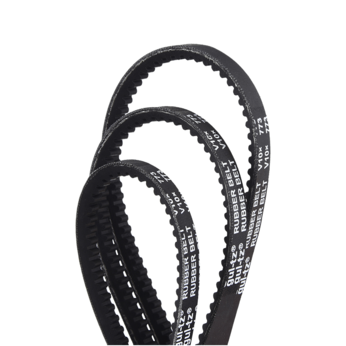How does the tensile strength of a ribbed belt affect its service life
Ribbed belts, as an important component in modern mechanical transmission systems, are widely used in automobiles, industrial equipment, household appliances and other fields. Its main function is to transmit power between various components through friction to achieve efficient and stable operation. Tensile strength, as one of the key performance indicators of ribbed belts, has a profound impact on their service life.
Definition and importance of tensile strength
Tensile strength refers to the maximum stress that a ribbed belt can withstand when stretched by external force. It reflects the belt's resistance to external forces when transmitting power. Ribbed belts are usually made of composite materials such as synthetic rubber, nylon, and steel wire, in which the steel wire and nylon layers are responsible for providing the necessary tensile strength to ensure that the belt maintains a stable shape and size during long-term use.
Tensile strength directly affects the tension capacity, deformation resistance and wear resistance of the ribbed belt. When the tensile strength is insufficient, the belt is prone to elongation, deformation, or even breakage, which seriously affects its transmission efficiency and service life.
Tensile strength and tension distribution
The transmission performance of the ribbed belt is closely related to its tension distribution. The belt will withstand tension from the driving wheel and the driven wheel during operation. Too low tensile strength makes it impossible for the belt to maintain sufficient tension when it is loaded, causing the belt to slip and increase energy loss. On the other hand, if the tensile strength of the belt is too high, although it can withstand a larger load, it may also cause other components such as tensioners and hubs to be burdened, thus affecting the stability of the entire transmission system.
Therefore, appropriate tensile strength can ensure that the tension of the ribbed belt is evenly distributed when transmitting power, avoiding belt aging or breakage caused by excessive stretching, and extending the service life of the belt.
The effect of tensile strength on belt fatigue life
In practical applications, the operation of the ribbed belt is not just static stretching, it also needs to withstand repeated cyclical working loads. This load change will cause the belt to bend, elongate and compress continuously. As the number of uses increases, the belt material will gradually fatigue. Ribbed belts with lower tensile strength are more likely to break or wear under frequent load changes, resulting in a greatly shortened service life.
Ribbed belts with higher tensile strength can better resist this fatigue stress and maintain good shape and transmission performance. In a high-frequency working environment, the higher the tensile strength of the belt, the longer its fatigue life and the more stable it can operate for a longer period of time.
Effect of tensile strength on belt wear
The wear of ribbed belts is closely related to their tensile strength. During the working process of the belt, friction is one of the main causes of belt wear. Belts with insufficient tensile strength are prone to excessive stretching and deformation during the transmission process, resulting in increased surface friction, which accelerates the wear process. Especially in high load or high temperature environments, belts with low tensile strength are more susceptible to damage.
On the contrary, ribbed belts with higher tensile strength can better withstand external loads, reduce deformation, and thus reduce the wear rate and extend the service life. Ribbed belts with high tensile strength can maintain a low wear rate under long-term operation, reducing performance degradation or failure caused by excessive wear.
Tensile strength and environmental adaptability
Environmental conditions also have a significant effect on the tensile strength and service life of ribbed belts. In harsh environments such as high temperature, low temperature, humidity or chemical corrosion, ribbed belts with low tensile strength are prone to aging, deformation and performance degradation, thereby shortening their service life. Ribbed belts with higher tensile strength can better adapt to these environments and maintain relatively stable transmission performance.
For example, in automobile engines, ribbed belts need to withstand factors such as high temperature and oil pollution. Belts with high tensile strength can better resist thermal expansion and deformation, avoiding the risk of transmission failure. Therefore, in high-temperature working environments, ribbed belts with high tensile strength can greatly improve the reliability and service life of the product.
Advantages of high tensile strength ribbed belts
Extend service life: By increasing the tensile strength, the ribbed belt can maintain stable transmission performance for a longer period of time, reducing the cost of frequent belt replacement.
Improve transmission efficiency: Ribbed belts with high tensile strength can better maintain tension, avoid slipping, and improve power transmission efficiency.
Strong fatigue resistance: High tensile strength enables the belt to better resist fatigue damage caused by repeated loads, ensuring long-term stable operation.
Adapt to harsh environments: In extreme environments such as high temperature, low temperature, and humidity, belts with high tensile strength perform better and have strong adaptability.
Hot Products
-
 View More
View More
-
 View More
View More
V-belt For Industry
-
 View More
View More
T Type Industry Rubber Synchronous Belt
-
 View More
View More
Toothed wedge belt
-
 View More
View More
Thickened timing belt
-
 View More
View More
Open Timing Belt
-
 View More
View More
Automotive V-belt
-
 View More
View More
Rubber Flat Belt
-
 View More
View More
Ribbed Belt
-
 View More
View More
Synchronous Pulley
-
 View More
View More
Arc tooth industrial rubber synchronous belt
-
 View More
View More
Automotive timing belt

 English
English 简体中文
简体中文
